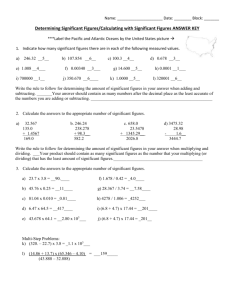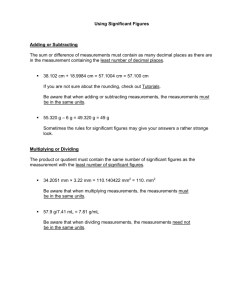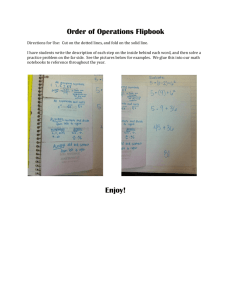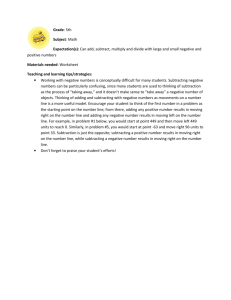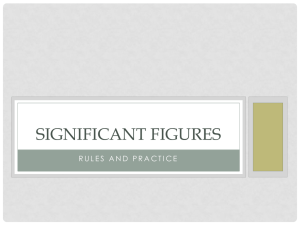OPERATIONS WITH SIGNED NUMBERS DIVISION same signs
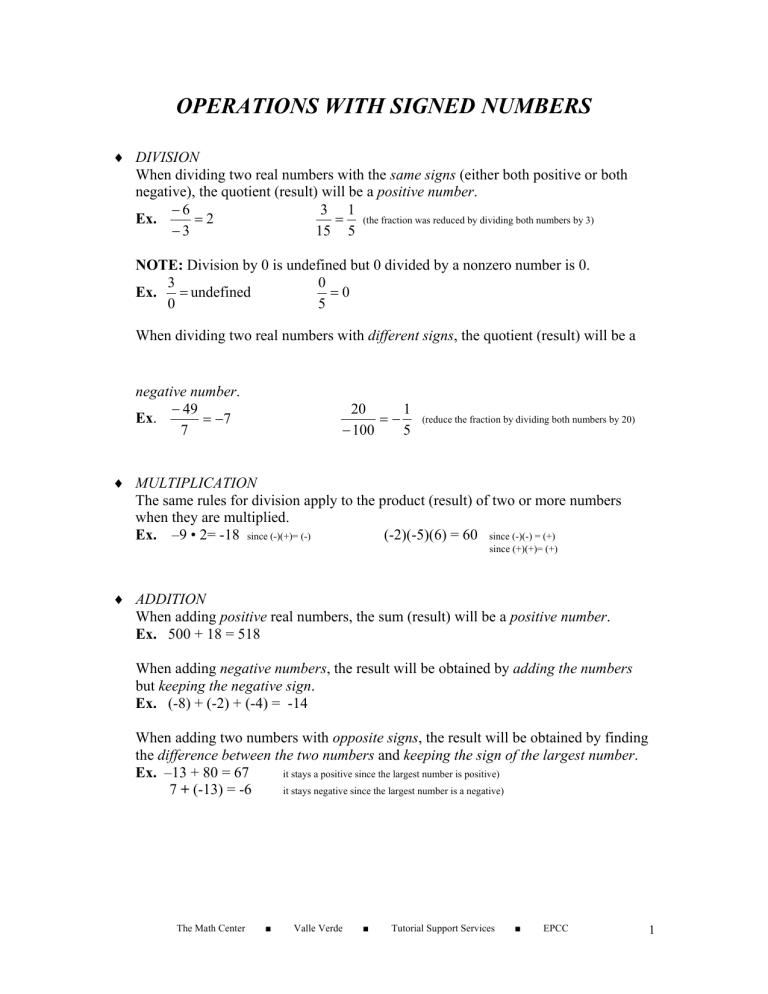
OPERATIONS WITH SIGNED NUMBERS
♦
DIVISION
When dividing two real numbers with the same signs (either both positive or both negative), the quotient (result) will be a positive number
.
Ex.
−
−
6
3
= 2
3
15
=
1
5
(the fraction was reduced by dividing both numbers by 3)
NOTE:
Division by 0 is undefined but 0 divided by a nonzero number is 0.
Ex.
3
0
= undefined
0
5
= 0
When dividing two real numbers with different signs
, the quotient (result) will be a negative number
.
Ex
.
−
7
49
= − 7
−
20
100
= −
1
5
(reduce the fraction by dividing both numbers by 20)
♦
MULTIPLICATION
The same rules for division apply to the product (result) of two or more numbers when they are multiplied.
Ex.
–9 • 2= -18 since (-)(+)= (-)
(-2)(-5)(6) = 60 since (-)(-) = (+)
since (+)(+)= (+)
♦
ADDITION
When adding positive
real numbers, the sum (result) will be a positive number
.
Ex.
500 + 18 = 518
When adding negative numbers
, the result will be obtained by adding the numbers but keeping the negative sign
.
Ex.
(-8) + (-2) + (-4) = -14
When adding two numbers with opposite signs
, the result will be obtained by finding the difference between the two numbers
and keeping the sign of the largest number
.
Ex. –13 + 80 = 67 it stays a positive since the largest number is positive)
7
+
(-13) = -6
it stays negative since the largest number is a negative)
The Math Center ■ Valle Verde ■ Tutorial Support Services ■ EPCC 1
♦
SUBTRACTION
If subtracting two numbers and the largest number is the minuend (the first number) then the difference (result) is obtained by subtracting the numbers and keeping a positive sign
.
Ex.
93 – 41 = 52
If subtracting two numbers and the largest number is the subtrahend (the second number) then the difference is obtained by subtracting the numbers and keeping a negative sign
.
Ex.
41 – 212 = -171
If subtracting two numbers that both have the negative sign
, add the numbers and keep the negative sign .
Ex.
-20 – 15 = -35
ORDER OF OPERATIONS
Just as following a recipe to make a cake, there is also an order when simplifying a mathematical expression. If the order of operations is not followed, the outcome will be wrong. The best way to remember the order of operations is by the following sentence:
P lease e xcuse m y d ear a unt
S ally. The operations are in order from the top to the bottom.
P arenthesis
E xponents
M ultiplication
D ivision
A ddition
S ubtraction
Ex.
Simplify:
(
2 + 3
)
2
5
5 2
− 7 ⇐
First perform the operation inside the parenthesis (addition in this case).
5
− 7
25
− 7 ⇐
The next operation to perform is exponents according to the PEMDAS guideline.
5
5-7 ⇐
Now, do the division since there are no parenthesis, exponents or multiplication in this expression.
-2 ⇐
Finally, subtract the numbers by keeping in mind that you are subtracting a large number from a smaller number, thus giving us a negative number.
EXERCISES
Simplify the following expressions:
+ –3²
[-18 / (2 + 1)²] -[3 • (14 – 20) + 5]
-4 • -5 • -3 + 2
(answer: 37)
(answer: 11)
(answer: -58)
The Math Center ■ Valle Verde ■ Tutorial Support Services ■ EPCC 2
